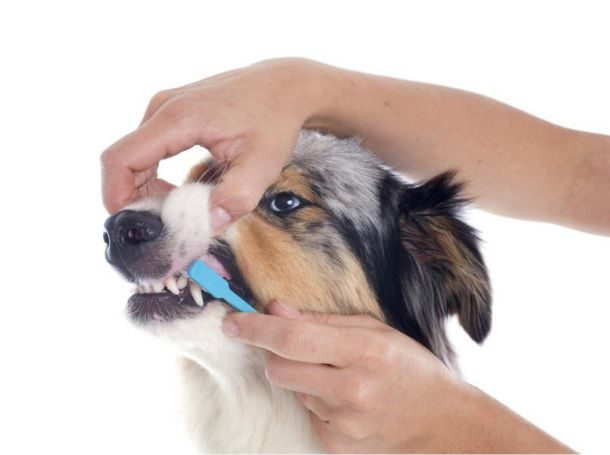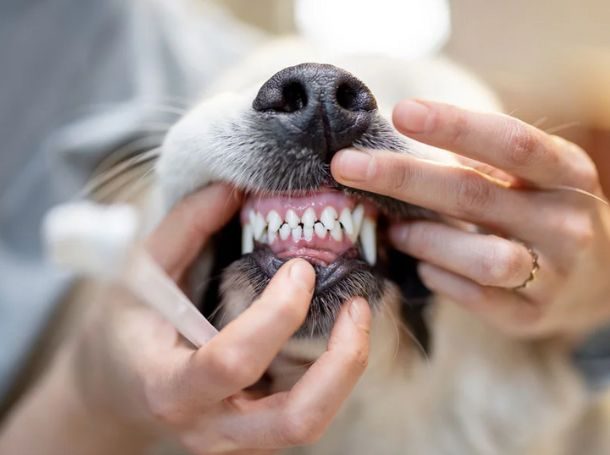
How to Brush Your Dog’s Teeth: A Step-by-Step Guide
- February 21, 2025
Table of Contents
Brushing your dog’s teeth might seem like a daunting task, but it is one of the most important aspects of maintaining their overall health. Just like humans, dogs can suffer from dental diseases that affect their gums, teeth, and even internal organs if left untreated. Regular brushing can prevent plaque build-up, bad breath, gum disease, and even tooth loss. In this guide, we will walk you through everything you need to know about brushing your dog’s teeth, from why it’s important to how to do it effectively.
Why is Brushing Your Dog’s Teeth Important?
Just like humans, dogs are prone to oral health problems if their teeth aren’t regularly cleaned. Without proper care, plaque can build up on your dog’s teeth, leading to tartar, gum disease, and tooth decay. The worst part is that your dog may not show obvious signs of a problem until it’s too late. Here’s why brushing is so crucial:
- Prevents Dental Disease: Plaque and tartar can cause inflammation and infection in your dog’s gums, which can eventually lead to periodontal disease.
- Fights Bad Breath: A common problem in dogs is halitosis (bad breath), which is often caused by bacteria in the mouth.
- Improves Overall Health: Poor dental hygiene can lead to more serious health issues, such as heart disease, liver disease, and kidney problems. This happens because bacteria from the mouth can enter the bloodstream and affect vital organs.
- Saves Money on Vet Bills: Dental treatments for dogs can be expensive. Regular brushing is an affordable way to avoid costly dental procedures and treatments.
What You’ll Need to Brush Your Dog’s Teeth
Before diving into the actual brushing process, it’s important to gather the right tools to make the experience as smooth as possible for both you and your dog:
- Dog Toothbrush: A dog-specific toothbrush has softer bristles and a design that’s easier to maneuver around their mouth. You can also use finger brushes, which fit over your finger and give you more control.
- Dog Toothpaste: Always use toothpaste formulated for dogs. Human toothpaste contains ingredients like xylitol, which is toxic to dogs. Dog toothpaste comes in flavors like peanut butter, poultry, or vanilla, making it more appealing to your dog.
- Dental Chews and Toys: While they aren’t a substitute for brushing, dental chews can help reduce plaque and tartar build-up between brushings.
Step-by-Step Guide to Brushing Your Dog’s Teeth
Step 1: Get Your Dog Comfortable with Mouth Handling
Before you even think about brushing, you need to get your dog used to having their mouth and teeth handled. Start slowly by gently massaging their gums and lips. Here’s how:
- Start with Positive Reinforcement: Use treats and praise to reward your dog for being calm when you touch their face and mouth. This will help them associate the process with something positive.
- Touch the Teeth: Once your dog is comfortable with their mouth being touched, gently lift their lips to expose their teeth. Try to hold the top of their muzzle with one hand while using the other to touch their teeth.
- Build Up Gradually: Slowly increase the amount of time you spend around their mouth. If they show signs of distress, back off and try again later, always rewarding calm behavior.
Step 2: Find the Right Time and Place

Pick a quiet, calm environment to brush your dog’s teeth, free from distractions. Choose a time when your dog is relaxed and not overly energetic, such as after a walk or during downtime.
Step 3: Toothbrush and Toothpaste

- Let Them Taste the Toothpaste: Allow your dog to lick the toothpaste off your finger before introducing the toothbrush. This will help them get used to the flavor.
- Introduce the Brush: Gently show your dog the toothbrush. If using a finger brush, place it on your finger and let them sniff it. If you’re using a regular toothbrush, allow them to explore it with their nose.
Step 4: Begin Brushing in Small, Gentle Circlessd

- Start Slowly: Place the brush at the back of your dog’s mouth and gently brush in a circular motion. Focus on the outside of the teeth, as this is where plaque typically builds up.
- Go Slowly: Brushing your dog’s teeth can take some time, so be patient. Try brushing for a few seconds on each side, and gradually work up to longer sessions as your dog gets used to the routine.
- Brush the Gum Line: Make sure you brush along the gum line, as this area is most prone to plaque and tartar build-up. Be careful not to apply too much pressure, as dog’s gums can be sensitive.
- Don’t Forget the Molars: These teeth can be especially prone to plaque build-up, so make sure to get the back teeth and molars, too. However, make sure your dog is comfortable before you get too far back in the mouth.
Step 5: Rinse and Reward

Once you’ve finished brushing, give your dog a treat and lots of praise. Rinse their mouth with water, if necessary. Over time, your dog will begin to associate tooth brushing with positive reinforcement, making it easier for both of you.
How Often Should You Brush Your Dog’s Teeth?
The ideal frequency for brushing your dog’s teeth is at least 3 times a week. However, daily brushing is the best way to ensure optimal dental health. If brushing every day is not feasible, aim for at least 2-3 times per week to reduce plaque and prevent tartar from building up.
Common Challenges and How to Overcome Them
1. Reluctance to Open the Mouth
Some dogs are simply not used to having their mouths opened, and this can be frustrating for both of you. If your dog is resistant, try the following:
- Start with a clean, soft cloth: Rub it gently around their gums and teeth before transitioning to the toothbrush.
- Break it down: Gradually build up to the brushing step by first touching their face, then lips, and working your way up.
2. Bitterness of Toothpaste
While many dog toothpaste options come in flavors dogs love, not all dogs enjoy the taste. If your dog is turning their nose up at the paste, try a different flavor, or use a small amount at first until they gets used to it.
3. Short Sessions
If your dog isn’t a fan of long brushing sessions, start with very short sessions (30 seconds to a minute) and build up the time. Reward them after each session, and soon they’ll become accustomed to the process.
Additional Tips for Maintaining Your Dog’s Dental Health
- Provide Dental Chews: Dental chews are a great supplement to brushing, as they help reduce plaque and tartar build-up.
- Schedule Regular Vet Check-ups: Regular dental exams by your vet will help catch any underlying issues early on.
- Diet Matters: A balanced, nutritious diet supports overall health, including your dog’s dental health. Some kibble brands are specifically designed to promote oral hygiene.
Conclusion
Brushing your dog’s teeth is an essential part of their overall health routine, and with the right approach, it can become an enjoyable part of your bonding time. Starting early and making the experience positive will ensure your dog’s teeth remain healthy and strong for years to come. Whether you’re just starting or need to refine your brushing technique, this guide provides the steps necessary to get your dog used to the process and help you maintain their dental health effectively.
Frequently Asked Questions (FAQs) About Brushing Your Dog’s Teeth
1. How often should I brush my dog’s teeth?
Ideally, you should brush your dog’s teeth every day to maintain optimal oral health. However, brushing 2-3 times a week can still help reduce plaque and tartar build-up. If daily brushing isn’t possible, aim for at least 3 times a week.
2. Can I use human toothpaste to brush my dog’s teeth?
No, you should never use human toothpaste for brushing your dog’s teeth. Human toothpaste contains fluoride and other ingredients like xylitol, which are toxic to dogs. Always use toothpaste made specifically for dogs, which is safe and often comes in dog-friendly flavors like peanut butter or poultry.
3. My dog doesn’t like having their teeth brushed. What can I do?
If your dog is reluctant to have their teeth brushed, start by getting them used to having their mouth and gums handled. Begin with a soft cloth or gauze to rub around their teeth and gums before using a toothbrush. Gradually build up to using a dog toothbrush, and always offer praise and treats to reinforce positive behavior.
4. What if my dog has bad breath? Is it related to their teeth?
Yes, bad breath in dogs is often a sign of plaque build-up, gum disease, or other oral health problems. Regular brushing can help reduce bad breath by removing the bacteria that cause it. If your dog’s breath persists despite regular brushing, consider visiting a vet for a professional dental check-up.
5. Can brushing my dog’s teeth prevent dental disease?
Yes, regular brushing is one of the best ways to prevent dental disease in dogs. It helps remove plaque before it hardens into tartar, reducing the risk of gum disease, tooth decay, and other dental issues. Dental chews and professional cleanings at the vet also contribute to maintaining your dog’s oral health.
6. Should I use a special toothbrush for my dog?
Yes, always use a toothbrush designed specifically for dogs. These toothbrushes have softer bristles, making them gentler on your dog’s gums and teeth. You can also opt for a finger brush if that’s easier for you to use, especially for smaller dogs.
7. Can I use dental chews instead of brushing my dog’s teeth?
While dental chews can help reduce plaque and tartar, they should not replace regular brushing. They are a great supplement, but brushing is the most effective way to maintain your dog’s dental health. A combination of both is ideal.
8. My dog has tartar build-up. Should I still brush their teeth?
Yes, brushing can help slow down further tartar build-up, but if your dog already has a significant amount of tartar, a professional dental cleaning by a vet may be necessary. Afterward, regular brushing will help maintain their oral health.
9. Can I brush my dog’s teeth with just water?
Brushing your dog’s teeth with just water may help remove some surface plaque, but it won’t effectively prevent tartar buildup or combat bad breath. Using dog-specific toothpaste is important for providing the antibacterial benefits needed to promote oral health.
10. At what age should I start brushing my dog’s teeth?
It’s best to start brushing your dog’s teeth as early as possible, ideally as a puppy. This helps them get used to the process and reduces the chances of resistance later on. If you have an older dog, don’t worry—you can start brushing their teeth at any age, though it may take more time to get them used to it.
11. How do I know if my dog has dental disease?
Signs of dental disease in dogs include bad breath, red or swollen gums, yellow or brown tartar on teeth, difficulty eating or chewing, and excessive drooling. If you notice any of these signs, it’s best to take your dog to the vet for a professional dental exam.
12. Can brushing my dog’s teeth save me money on dental bills?
Yes! Regular brushing can prevent the need for expensive dental procedures, such as professional cleanings and extractions. By maintaining your dog’s dental health at home, you can save money in the long run.
13. What if my dog won’t let me brush their teeth?
If your dog is very resistant to tooth brushing, try starting with a gradual approach. Begin by touching their face, then lips, and slowly work your way to their teeth. Be patient, use positive reinforcement, and reward calm behavior with treats. If brushing is still difficult, consider using dental wipes or sprays as a temporary solution until they become more comfortable.
14. How long does it take to brush my dog’s teeth?
The entire brushing process should take around 2-3 minutes. Start with just a few seconds on each side of the mouth and gradually increase the time as your dog becomes more accustomed to the routine. Be sure to give your dog lots of praise during and after the brushing session.
15. Is it okay if I don’t brush my dog’s teeth every day?
While daily brushing is ideal, brushing your dog’s teeth 2-3 times a week can still help maintain good dental hygiene. The key is to establish a routine and stay consistent, as regular brushing will help prevent serious oral health problems in the future.




Leave a comment